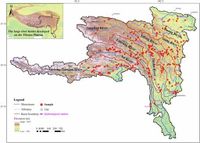The Tibetan Plateau plays a significant role in the global carbon cycle, especially through its unique weathering processes. A recent study significantly refines our understanding of how chemical weathering, specifically involving carbonate and silicate weathering, influences atmospheric CO2 levels in this pristine environment.
Researchers focused on the delicate balance between carbonic and sulfuric acid-mediated weathering in the Tibetan Plateau. They discovered that while carbonate weathering contributes to CO2 output, over 80% of the sulfuric acid generated in this region comes from the oxidation of pyrite and is consumed during carbonate weathering. This interaction ultimately counters about 58% of the CO2 consumption flux associated with silicate weathering processes on the plateau.
The study calculated the average total dissolved solids (TDS) for the region’s rivers at 215.8 mg L−1, which is notably higher than the global mean of 100 mg L−1. Additionally, carbonate weathering was found to contribute an average of 72.8% to the total cationic loads in the river systems, contrasting with silicate weathering, which averaged only 17.0%
Moreover, the researchers reported that the riverine sulfate originating from oxidative weathering of pyrite (OWP) is approximately 56.0%, much higher than the average global estimate of 45%. This high proportion emphasizes the Tibetan Plateau's unique geological processes, particularly in relation to its erosional processes driven by tectonics and glaciation.
In terms of weathering rates, the Tibetan Plateau has an average rate of 41.7 t km−2 a−1, more than double the global average of 21 t km−2 a−1. However, the researchers noted that the enhanced carbonate weathering fluxes—accounting for 2.09% of global fluxes—rarely surpassed the rates seen in the downstream regions.
Another important finding from this study indicates that the Tibetan Plateau serves as a long-term CO2 sink, with a net consumption flux of 33.2 × 109 mol a−1. If sulfuric acid weathering is ignored, this figure would have been significantly higher at 79.4 × 109 mol a−1. Thus, the interaction between sulfuric and carbonate weathering plays a critical role in regulating CO2 levels.
Researchers employed rigorous sampling methods across major river networks in the Tibetan Plateau, utilizing methods such as mass budget equations and isotopic analysis to reveal these significant insights. Their systematic approach not only sheds light on the complexities of Himalayan weathering processes but also illustrates the necessity of considering sulfuric acid impacts when evaluating carbon cycling affected by orogenesis.
Ultimately, these revelations have broader implications for understanding the climatic influence of the Tibetan Plateau in historical geological contexts. As the formation of this plateau aligns closely with significant periods of atmospheric CO2 variation, the presence and effects of sulfuric acid involvement in carbonate dissolution raise questions regarding previously established geological feedback mechanisms.
This comprehensive study illustrates the delicate balance of factors impacting carbon cycling in one of the world’s most significantly elevated landscapes, thereby advancing our understanding of how mountain formation can modulate atmospheric carbon levels.
By validating these complex interactions, researchers provide strong evidence that the weathering processes on the Tibetan Plateau yield both atmospheric CO2 release and consumption, suggesting need for future studies to explore these variables in detail for a holistic view of global carbon dynamics.

